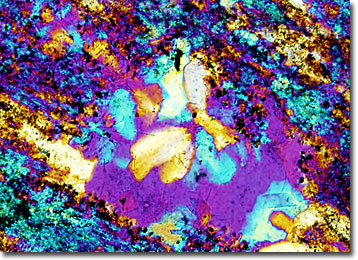Polarized Light Microscopy Digital Image Gallery
Rhyolite Flow
Rhyolite is primarily composed of orthoclase feldspar and quartz, but plagioclase feldspar, pyroxenes, amphiboles, and biotite are often present as well, although in smaller amounts. Due to its mineralogical composition, the rock is often considered the volcanic equivalent of granite.

Rhyolite is an extrusive igneous rock that is usually light in color, often exhibiting, white, gray, brownish, magenta, or reddish hues. Samples may also be multicolored or exhibit distinct banding. Certain varieties of rhyolite are utilized as gemrocks or for ornamental purposes. A thinly banded type is commonly known as wonderstone, although the same name is sometimes applied to a similar looking variety of banded sandstone. Some spherulitic rhyolites are known commercially as birdseye, and other ornamental types of rhyolite have been known by the names elixerite, hickoryite, and liparite.
Relatively common, rhyolite flows are often found near volcanic vents and may exhibit markings or structural bands that were produced by the movement of the lava from which it formed as it cooled along the surface of the Earth. Though found around the world, some of the most breathtaking examples of flows and other types of rhyolite, such as porphyries, can be seen in Yellowstone National Park. In fact, the Grand Canyon of the Yellowstone, which is approximately 20 miles long, 1,500 to 4,000 feet wide, and as many as 1,200 feet deep, is primarily carved out of an extensive deposit of rhyolite flow, the first layers of which were generated by massive volcanic eruptions some 600,000 years ago.
